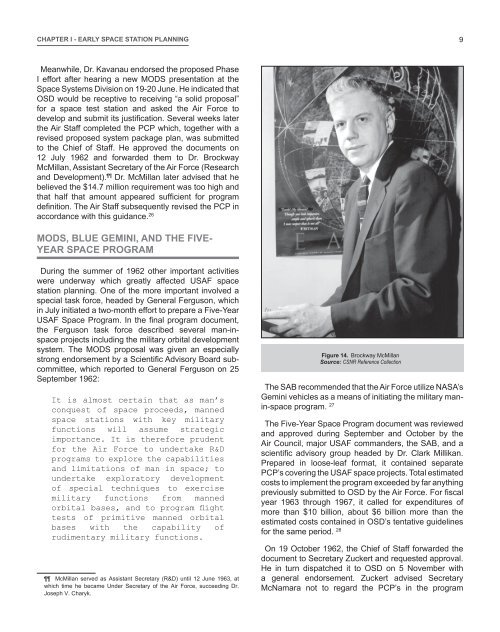NRO-MOL_2015
Create successful ePaper yourself
Turn your PDF publications into a flip-book with our unique Google optimized e-Paper software.
Chapter I - Early Space Station Planning<br />
9<br />
Meanwhile, Dr. Kavanau endorsed the proposed Phase<br />
I effort after hearing a new MODS presentation at the<br />
Space Systems Division on 19-20 June. He indicated that<br />
OSD would be receptive to receiving “a solid proposal”<br />
for a space test station and asked the Air Force to<br />
develop and submit its justification. Several weeks later<br />
the Air Staff completed the PCP which, together with a<br />
revised proposed system package plan, was submitted<br />
to the Chief of Staff. He approved the documents on<br />
12 July 1962 and forwarded them to Dr. Brockway<br />
McMillan, Assistant Secretary of the Air Force (Research<br />
and Development). Dr. McMillan later advised that he<br />
believed the $14.7 million requirement was too high and<br />
that half that amount appeared sufficient for program<br />
definition. The Air Staff subsequently revised the PCP in<br />
accordance with this guidance. 26<br />
MODS, Blue Gemini, and the Five-<br />
Year Space Program<br />
During the summer of 1962 other important activities<br />
were underway which greatly affected USAF space<br />
station planning. One of the more important involved a<br />
special task force, headed by General Ferguson, which<br />
in July initiated a two-month effort to prepare a Five-Year<br />
USAF Space Program. In the final program document,<br />
the Ferguson task force described several man-inspace<br />
projects including the military orbital development<br />
system. The MODS proposal was given an especially<br />
strong endorsement by a Scientific Advisory Board subcommittee,<br />
which reported to General Ferguson on 25<br />
September 1962:<br />
It is almost certain that as man’s<br />
conquest of space proceeds, manned<br />
space stations with key military<br />
functions will assume strategic<br />
importance. It is therefore prudent<br />
for the Air Force to undertake R&D<br />
programs to explore the capabilities<br />
and limitations of man in space; to<br />
undertake exploratory development<br />
of special techniques to exercise<br />
military functions from manned<br />
orbital bases, and to program flight<br />
tests of primitive manned orbital<br />
bases with the capability of<br />
rudimentary military functions.<br />
McMillan served as Assistant Secretary (R&D) until 12 June 1963, at<br />
which time he became Under Secretary of the Air Force, succeeding Dr.<br />
Joseph V. Charyk.<br />
Figure 14. Brockway McMillan<br />
Source: CSNR Reference Collection<br />
The SAB recommended that the Air Force utilize NASA’s<br />
Gemini vehicles as a means of initiating the military manin-space<br />
program. 27<br />
The Five-Year Space Program document was reviewed<br />
and approved during September and October by the<br />
Air Council, major USAF commanders, the SAB, and a<br />
scientific advisory group headed by Dr. Clark Millikan.<br />
Prepared in loose-leaf format, it contained separate<br />
PCP’s covering the USAF space projects. Total estimated<br />
costs to implement the program exceeded by far anything<br />
previously submitted to OSD by the Air Force. For fiscal<br />
year 1963 through 1967, it called for expenditures of<br />
more than $10 billion, about $6 billion more than the<br />
estimated costs contained in OSD’s tentative guidelines<br />
for the same period. 28<br />
On 19 October 1962, the Chief of Staff forwarded the<br />
document to Secretary Zuckert and requested approval.<br />
He in turn dispatched it to OSD on 5 November with<br />
a general endorsement. Zuckert advised Secretary<br />
McNamara not to regard the PCP’s in the program

















